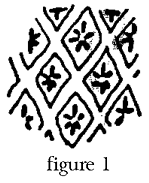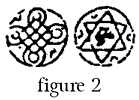 |
Occasionally I have found fabric that looked right, but I hesitated because the design was printed instead of woven. Or I wanted to paint or print fabric but was told that it "wasn't period". Take heart! Not only is it period, but it is early period.
Many scholars think that printed textiles and block printing originated in India around 3000 BC although no textiles or blocks have survived. Printed textiles were used in the Caucasus mountain region around 2000 BC. Herodotus (450 BC) tells about peoples from that area who painted animal figures on their clothing. Strabo (63 BC to 20 AD) documents Indian printed textiles and Pliny the elder (23-79 AD) describes what sounds like the painting of textiles before dyeing with various mordants to color the fabric in various colors.
|
 |
Fabrics for printing were silk, cotton and linen and were probably prepared by singeing or cropping to form a hard surface for printing. Printing could be done by using a carved block of wood or other material, coating it with pigment and then impressing it into the material. Another method is to apply a resist (a substance that keeps the material from absorbing dye) int a pattern by either painting it on or stamping it on with a block. The fabric to print the fabric with a mordant solution so that only the parts mordanted took the dye. One further way was to dye the fabric and then remove the dye from parts of it with a bleaching agent.
|
 |
The earliest printed textile known is a child's tunic from Achmim is upper Egypt. It dates from the 4th century AD . It is white linen block-printed in blue with a diamond shaped pattern containing a star-shaped design (figure 1). Two early wooden blocks for printing remain. Their pattern is shown in figure 2.
Besides pigment, textiles were also printed with gums, resins, and gold powder or in some cases fine fiber flock were sprinkled on and adhered to the fabric to simulate more expensive brocades and (later) velvets. The earliest textiles were printed in one color only on undyed fabric using small blocks. By the tenth century, the fabric was often dyed and then printed in multiple colors including gold and silver. Textiles printed with gold powder have bee found in Persia (6th and 7th centuries).
|
The earliest European example of printed cloth comes from the tomb of St. Caesarius of Arles (502-43) in France. It is suspected that the textile is Egyptian in origin. Another example was found in the tomb of St. Cuthbert.
Sources:
Robinson, Stuart A History of Printed Textiles. MIT Press, Cambridge, Mass., 1969
|





